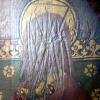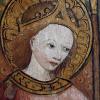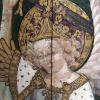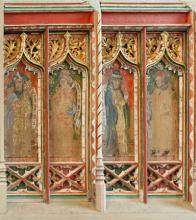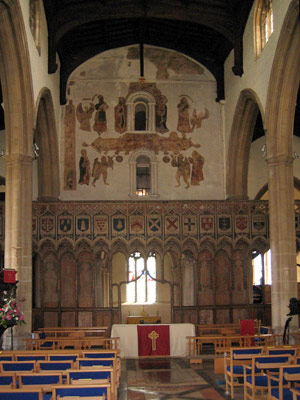 |
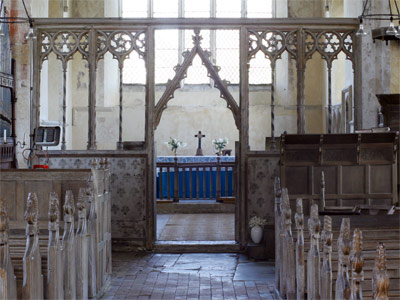 |
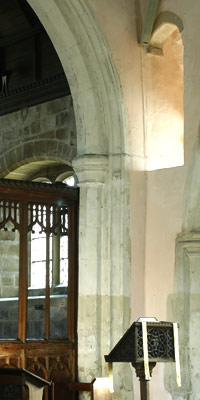 |
|
St Mary's, Attleborough, Norfolk |
Thompson, near Thetford, Norfolk |
Coton, Cambridgeshire |
Background and context
Despite a generally held perception that all pre-Reformation art was indiscriminately destroyed, East Anglia has Europe-wide pre-eminence in the quality and quantity of its surviving fourteenth- to sixteenth-century painted wooden church screens.
This mainly takes the form of rood-screens sited between the nave and chancel and there are more than five hundred surviving examples within the historical dioceses of Norwich and Ely.
HKI led research has demonstrated that late medieval screens are still found in 40% of regional medieval churches, providing a rare opportunity for building a more nuanced picture of the late-Middle Ages and early modern period through the integration of object-led technical investigation, archaeological, art historical and cultural research.
The HKI, a leading international institution in the technical study and conservation of medieval painted surfaces, began the first of a multi-phase set of projects concerning East Anglian screens in 2009.
Phase 1 - research
Phase 1 involved the survey of more than 500 screens and related objects in Norfolk, Suffolk and within the historical borders of Cambridgeshire, identifying for the first time the numbers and scope of the surviving objects.
In 2013 Dr Lucy Wrapson’s research on Patterns of production: a technical art historical study of East Anglia’s late medieval screens identified for the first time how screens were produced, uncovering groups of related carpentry and painting. This research provided the first technically based framework for a chronology of rood screens detailing the changing format and design of screens over time. This work established the intellectual value of research into rood screens and highlighted the critical importance of bringing to bear the methodologies of technical art history on the subject for the first time.
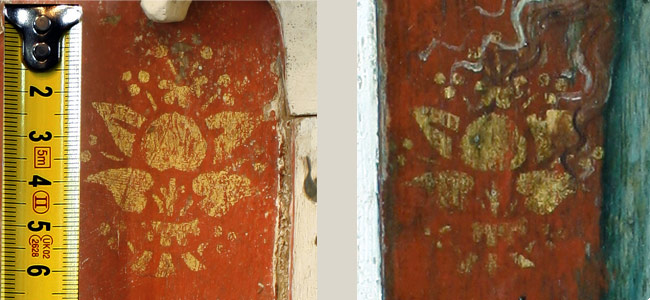 |
||
|
"...uncovering groups of related carpentry and painting..." The use of the same stencil can be observed at Thornham and Filby, both in Norfolk, but some 65 miles distant
|
||
Phase Two - research
Phase Two of the HKI's work on screens began in 2012 when Lucy Wrapson was approached by the Churches Buildings Council (CBC) to undertake a pilot study of the conservation condition of ten specific screens. The screens were surveyed by Lucy Wrapson and their church environments assessed by Tobit Curteis. This survey provided detailed conservation recommendations and laid the path for further research into new specialised conservation methodologies as well as advanced avenues of technical art historical study.
Since that time, practical conservation work on the screens surveyed has been undertaken by Lucy Wrapson at Belstead, Suffolk, North Tuddenham and Elsing, Norfolk, with further projects taking place in Ipswich and Lessingham.
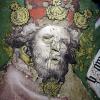 |
|
|
|
|
|
|
|
|
| eg of iconoclasm | eg. of iconoclasm | Barton Turf, Norfolk | St Michael at Ranworth | Thornham | Beeston Regis | |||
Phase 3 - planned research
Phase 3, The East Anglian Rood Screen Project was agreed in collaboration with CBC partners, fellow Cambridge academics Professor Paul Binski and Dr Donal Cooper, church architect Ruth Blackman and external conservation partners Tobit Curteis and Hugh Harrison.
Preservation
Preservation centres on the physical well-being of screens and relevant aspects of the church fabric. It requires the support of diverse relevant skills – paint, wood and building conservation - and, crucially, their integration. Preservation critically underpins the capacity to research: many screens cannot be properly seen due to their current condition.
Research and outreach
Recent scholarship on material culture has demonstrated the importance of combining methodologies from a range of disciplines. This third phase project would provide opportunities for doctoral training in these approaches.
Directed technical study will provide fresh insights in greater detail into both the original patronage and manufacture of screens and reveal a more nuanced picture of Reformation iconoclasm.
Vocational outreach will take the form of conservation internships, fellowships and apprenticeships, enabling the transfer of unusual and threatened skill-sets such as the conservation of medieval polychrome wood. Community outreach will involve engagement and involvement with individual parishes and schools.
Documentation
Key to this will be the conservation survey of c. 500 churches and screens. The geographical scope would encompass Norfolk, Suffolk and Cambridgeshire. The project terms of reference include all medieval screens (including parclose screens), whether painted, stripped or restored.
Emergency intervention
Some capacity for responsive action to conservation needs in parallel with the planned survey is required. The focus would be holistic – on the screens, the fabric of their built envelopes and the parishes which use and maintain them.
Publications
L. J. Wrapson, 'A Medieval Context for the Artistic Production of Painted Surfaces in England Evidence from East Anglia c.1400–1540', in in T. Cooper, A. Burnstock, M. Howard and E. Town, Painting in Britain 1500–1630, Production, Influences and Patronage, London, 2015, pp. 166-175.
L. J. Wrapson, 'East Anglian medieval church screens. A brief guide to their physical history’, Bulletin of the Hamilton Kerr Institute, 4, 2013, pp. 33-47.
L. J. Wrapson, ‘East Anglian Rood-screens: the Practicalities of Production’, in Patrons and Professionals in the Middle Ages. Proceedings of the 2010 Harlaxton Symposium, New and Binski (eds), Donington, 2012, pp. 386-404.
L. J. Wrapson with C. Tracy and H. Harrison, ‘Thomas Spring’s Chantry and Parclose at Lavenham, Suffolk’, Journal of the British Archaeological Association, 164, 2011, pp. 221-59.
S. A. Cotton, H. E. Lunnon and L. J. Wrapson, ‘Medieval roodscreens in Suffolk-their construction and painting dates’, Proceedings of the Suffolk Institute of Archaeology, 43 (2), 2014, pp. 219-34.
S. Bucklow, 'Church screens and marking boundaries', Traditional Paint, 2011, 3, 2, pp. 22-27.
S. Bucklow, 'Reflections and translations – carving and painting rood screens', in Paint and Piety: Collected Essays on Medieval Painting and Polychrome Sculpture, ed. K. Kollandsrud and N. Streeton, Archetype, London, 2014, pp. 149-160.
Thornham, Barton Turf, Ranworth, North Tuddenham, Elsing, North Walsham, Tunstead and Cawston (Norfolk), Belstead and Yaxley (Suffolk).
27/12/13: http://www.theguardian.com/culture/2013/dec/27/east-anglian-rood-screens-decay and on Radio 4’s Making History (14/01/14: http://www.bbc.co.uk/programmes/b03phpg4).

